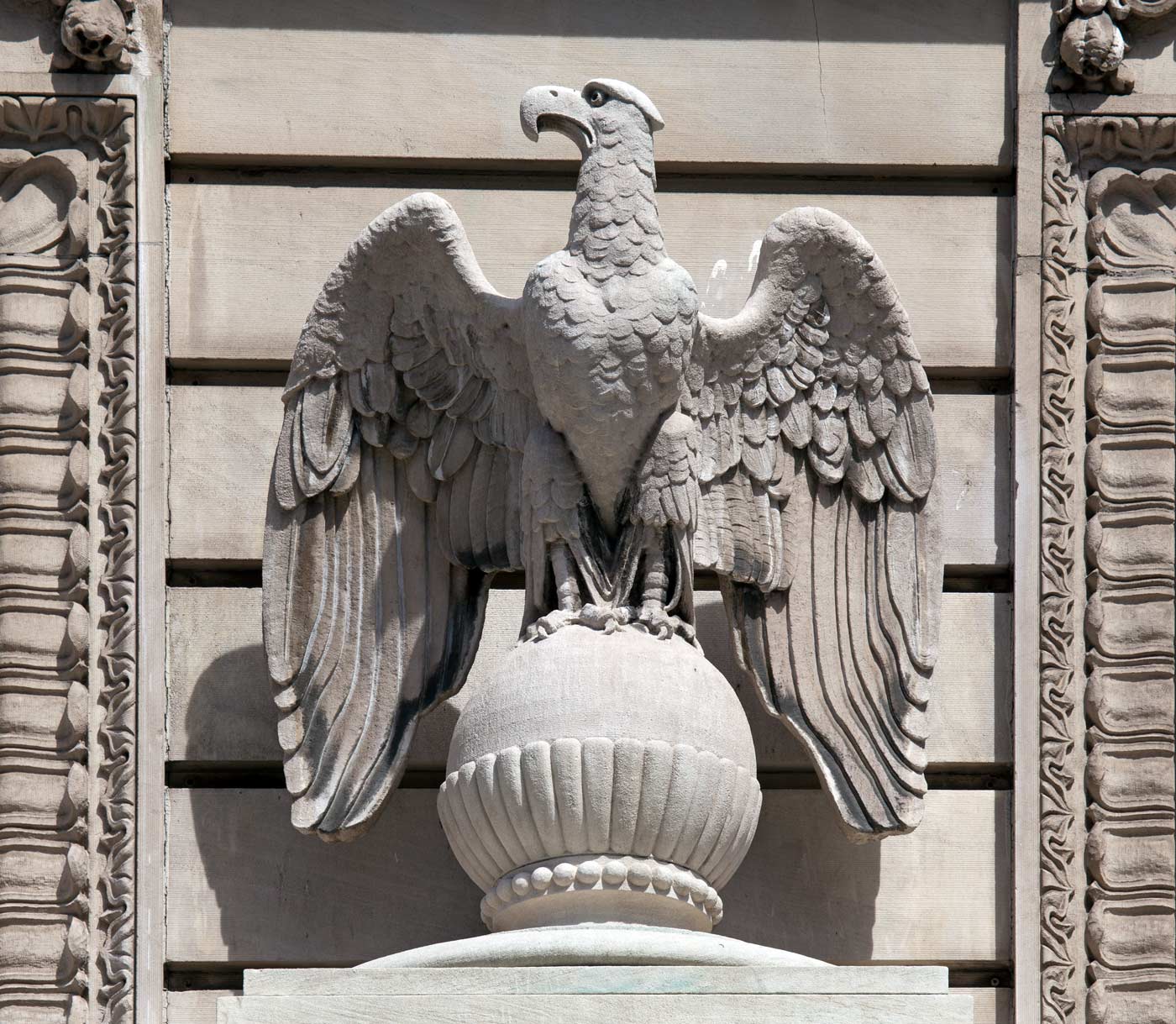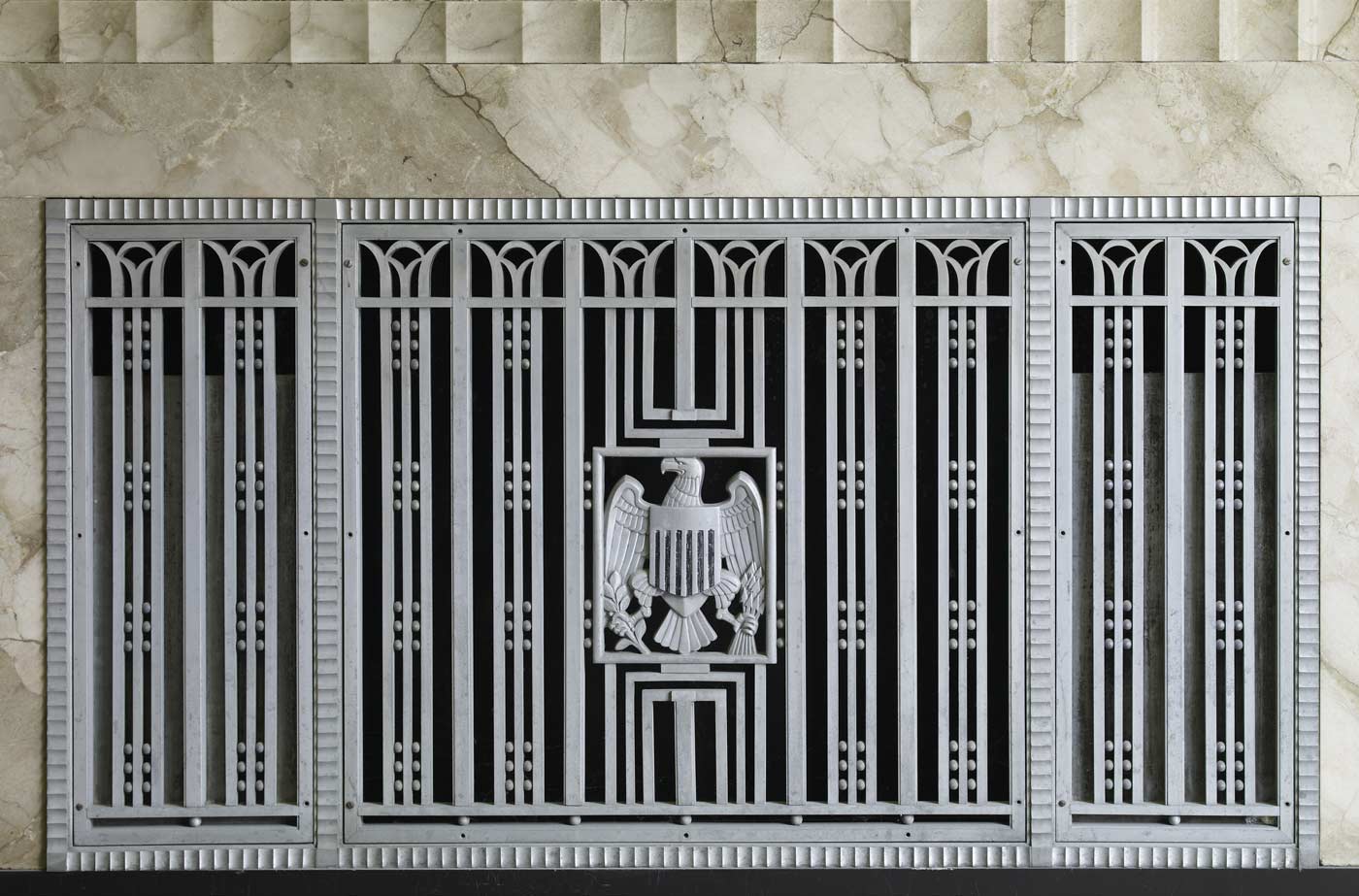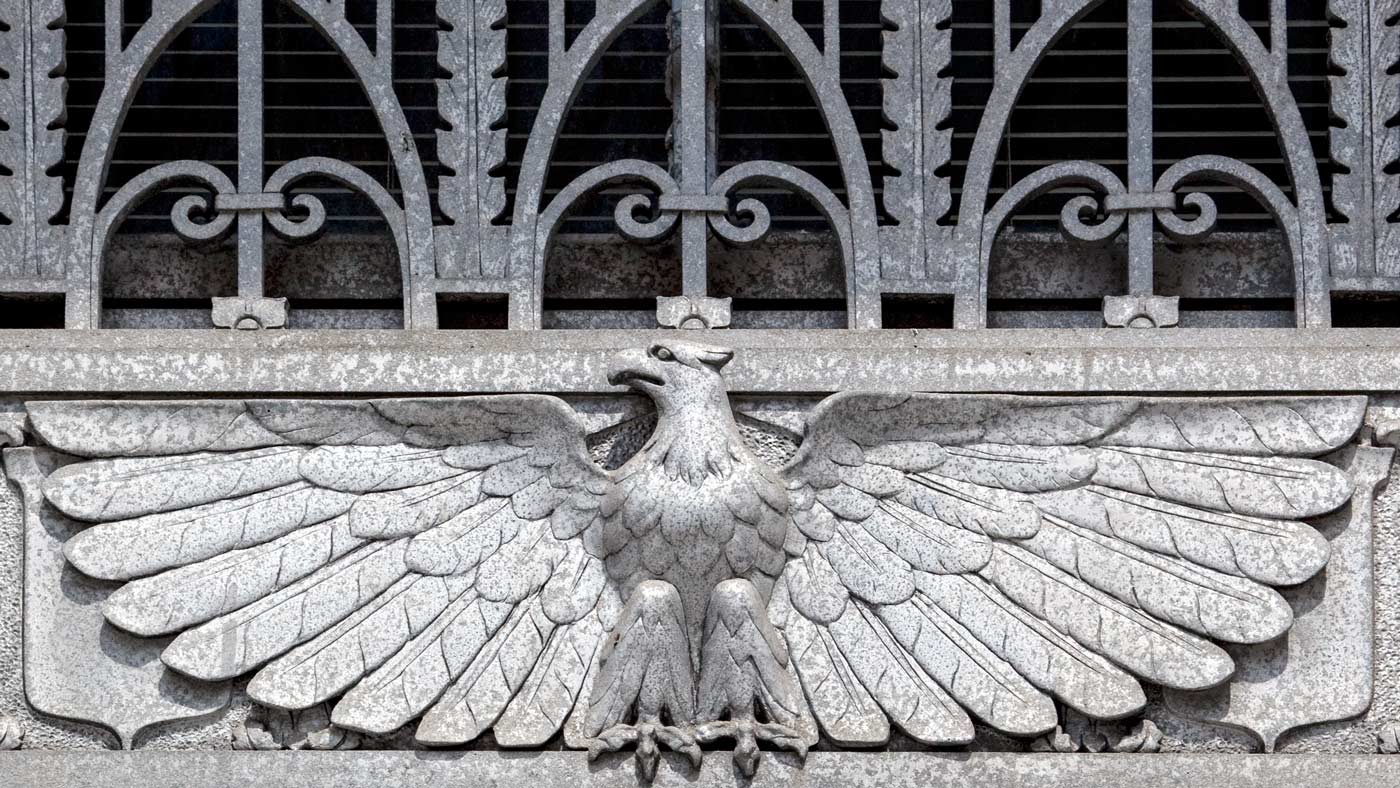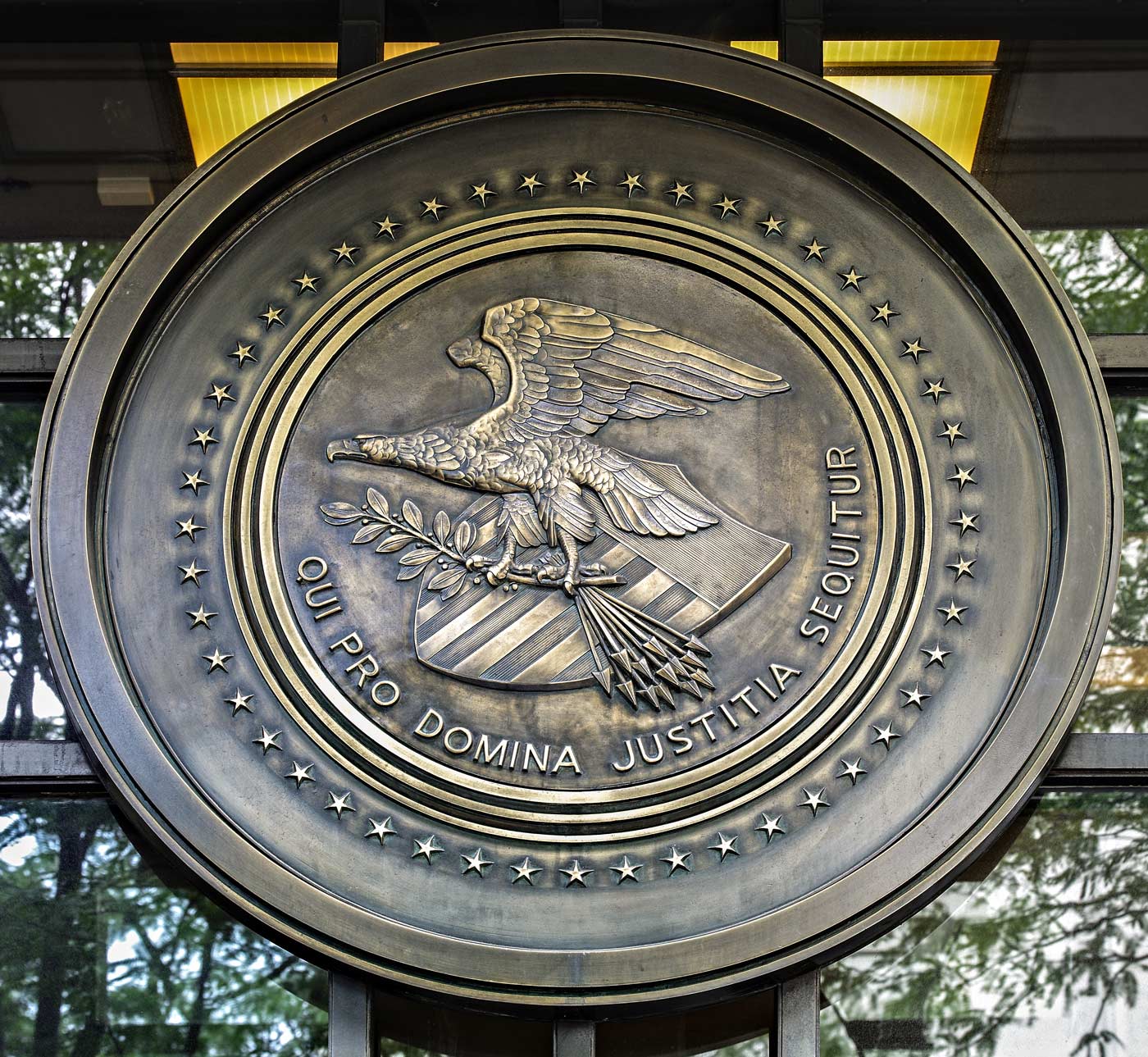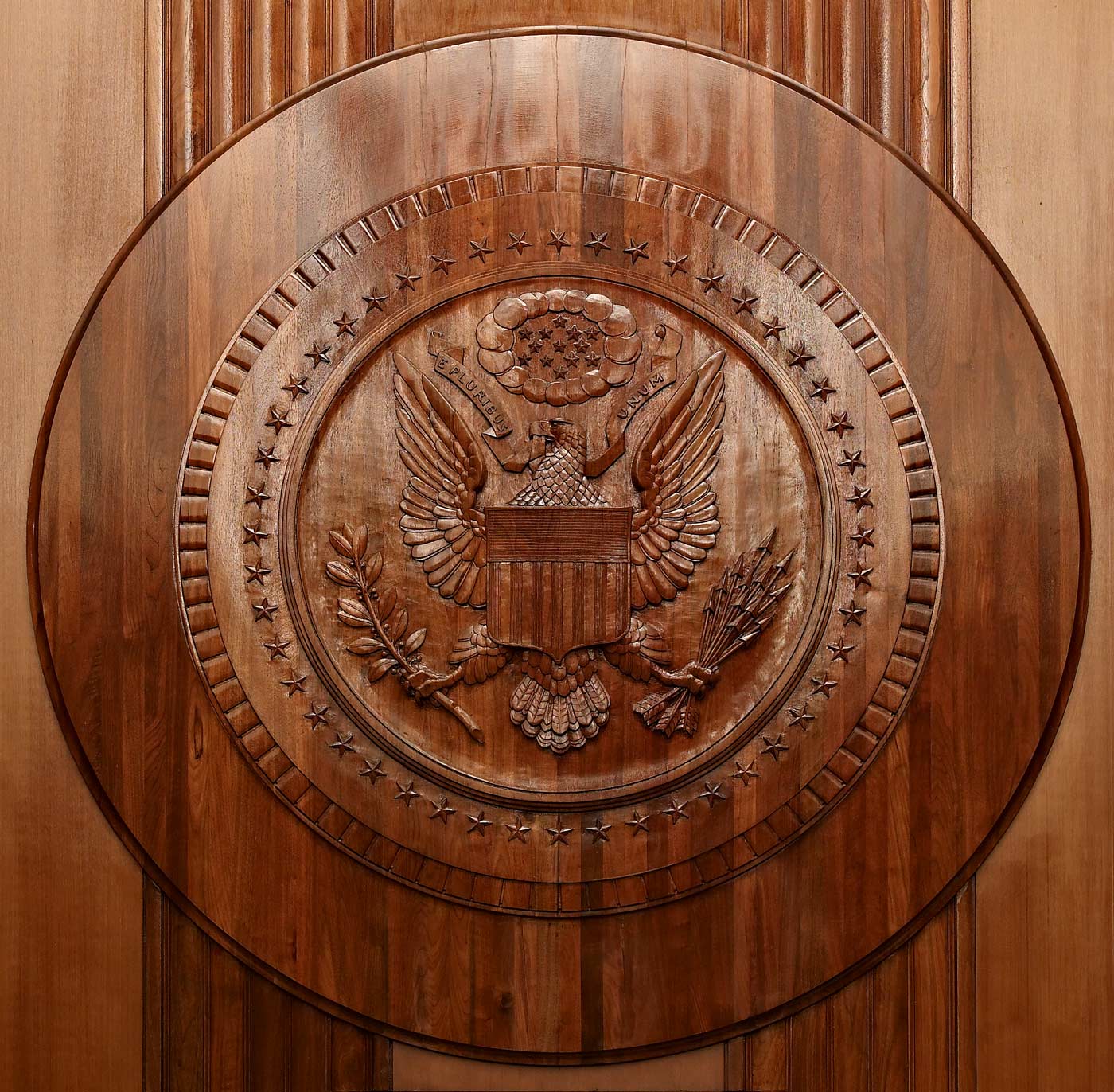US Bald Eagle Emblem in 1930s Art Deco Architecture

1936 U.S. Courthouse Eagle Detail, El Paso, Texas. Neoclassical, Art Deco designed by architect McGhee Fraser Lippencott. BUY A FINE ART PRINT
The US Emblem in the Art Deco architecture. By Carol M. Highsmith
Here an impressive selection of clean and essential pictures on the U.S. Symbol in US Courthouses and public buildings built from 1929 to 1939. All pictures, by Carol M. Highsmith are taken with a large-format view camera and the most recent with the finest professional digital equipment.
1931. Eagle detail on the Colorado Building, Washington, D.C. Designed by architect Ralph S. Townsend.
BUY FINE-ART PRINT
1932. James T. Foley U.S. Post Office and Courthouse, Albany, New York. Interior grill detail.
BUY FINE-ART PRINT
1932. James T. Foley U.S. Post Office and Courthouse, Albany, New York. Interior eagle detail.
BUY FINE-ART PRINT
1932. James T. Foley U.S. Post Office and Courthouse, Albany, New York. Interior lobby detail. Wood inlay eagle seal.
BUY FINE-ART PRINT
A legacy of the New Deal’s policies and WPA.
During the ‘1930s and 1940’ the public works and employment programs instituted by the Roosevelt administration, part of the government’s response to the Great Depression, created thousands of new buildings, and public artworks across the country. Source
The program was expanded with the creation of WPA, the Works Progress Administration. It was an American New Deal agency, employing millions of job-seekers (mostly unskilled men) to carry out public works projects, including the construction of public buildings and roads. It was established on May 6, 1935, by presidential order, as a key part of the Second New Deal. Source.
The legacy of these programs is invaluable.
1932. Exterior detail: eagle on stone. Clarkson S. Fisher Federal Building & U.S. Courthouse, Trenton, New Jersey.
The building is significant as a large WPA project. The exterior is a well-executed design with a “Stripped Neo-Classical” form featuring both Classical and Art Deco terra cotta detailing and fine grillwork. The interior of the building includes fine marble, brass, copper, and tile finishes, “New Deal Art” murals by Charles Wells, and impressive, almost completely intact courtrooms, public corridors, and judges’ chambers. More
BUY FINE-ART PRINT
1932. Exterior detail: eagle on iron. Clarkson S. Fisher Federal Building & U.S. Courthouse, Trenton, New Jersey.
BUY FINE-ART PRINT
1932
Clarkson S. Fisher Federal Building & U.S. Courthouse, Trenton, New Jersey.
Exterior detail.
BUY FINE-ART PRINT
1931
The Kennedy-Warren apartment building.
Washington, D.C.
Architect: Joseph Younger.
The Kennedy-Warren, also known as the “Old Lady”, was constructed from 1929 to 1931, and is considered the largest and best example of an Art Deco building in Washington.
BUY FINE-ART PRINT
1933. The John W. McCormack Post Office and U.S. Courthouse. Boston, Massachusetts. Architect: Ralph Adams Cram.
A superb example of monumental Art Deco civic architecture, the John W. McCormack U.S. Post Office and Courthouse presents intriguing exceptions to typical narratives of 1930s federal architecture. The use of Art Deco on large-scale federal buildings of that decade is rare. Originally named the U.S. Post Office, Courthouse, and Federal Building, it was designed by an architect famous for Gothic Revival ecclesiastical work. More
BUY FINE-ART PRINT
1933. The Sidney M. Aronovitz U.S. Courthouse, Post Office, and Customs House. Key West, Florida. Supervising Architect: James Alfonso Wetmore.
The passage of the Public Buildings Act of 1926 precipitated a period of building construction that was unprecedented in the United States. The Act specified that the office of the Supervising Architect of the Department of the Treasury would be responsible for the design and construction of all public buildings. The Key West Federal Building was constructed during this period, in 1930-1932.
The building is a two-story limestone-clad building. It is constructed of Key Largo limestone quarried at the Windley key quarry, a site now owned by the state of Florida. It is a Deco interpretation of a classical style. Source
BUY FINE-ART PRINT
1933 Monroe Post Office and US Courthouse. Monroe, Louisiana. Interior art grill. Architect: James Alonso Wetmore. Image source. The courthouse is a four-story building comprised of over 45,000 square feet and was built in 1933 by the Works Progress Administration, a U.S. government workforce consisting of citizens that were out of work. These men used A-model vehicles to hoist sandstone, brick, and mortar to construct this structure. The original inside walls were made of plaster, most of which has been replaced by gypsum wallboard. Source
BUY FINE-ART PRINT
1936. Courtroom eagle at U.S. Court House, Austin, Texas, Austin. Architects Charles H. Page / Kenneth Franzheim
An excellent example of Depression-era Moderne architecture. This style is revealed in its central massing, the rectangular form, the vertical flow of the window bays, the decorative metal grilles, and the geometric details. The exterior is also defined by reed-like pilasters, which enhance the vertical flow of the building while reflecting an element of restrained Neo-Classical influence.
BUY FINE-ART PRINT
1937. Exterior Medallion. Robert N.C. Nix Federal Building. Philadelphia, Pennsylvania. Architect: Harry Sternfeld.
A representative example of a relatively large, federally-funded, Depression-era project. Built under the auspices of the Public Works Administration (PWA), the building displays the stylistic approach of much late-1930s PWA architecture. A product of the locally prominent architect Harry Sternfeld (1888-1976) in association with the Ballinger Company (fl. 1920-present), it is one of a small number of high-quality Art Deco buildings constructed in Philadelphia. More
BUY FINE-ART PRINT
1937. Exterior Medallion. Robert N.C. Nix Federal Building. Philadelphia, Pennsylvania. Architect: Harry Sternfeld.
BUY FINE-ART PRINT
1937. Courtroom interior wooden detail. Robert N.C. Nix Federal Building. Philadelphia, Pennsylvania. Architect: Harry Sternfeld.
BUY FINE-ART PRINT
1938. Eagle at Federal Building and U.S. Court House, Peoria, Illinois. Architect Howard Lovewell Cheney.
This building was designed in the streamlined Art Moderne style, which was very popular in the late 1920s and the 1930s. This style emphasized the massing of simple geometric forms, as well as the use of repetitive window openings (typically grouped in multi-story, recessed vertical bands); contrasting light and dark building components; bas-relief wall ornamentation; and highly stylized (often geometric) forms for decorative design elements such as exterior lamps, handrails, and stone sculptures. More
BUY FINE-ART PRINT
1939-1944
Appraisers building.
San Francisco, California
Front exterior eagle detail.
Architect: Gilbert Stanley Underwood.
The United States Immigration Station and Appraisers Stores, San Francisco (now commonly called the Appraisers Building) housed immigration and customs agencies of the Federal government since its completion in 1944. The building embodies distinctive architectural characteristics spanning two significant periods in American architecture, the Depression and World War II.
BUY FINE-ART PRINT
A Bald Eagle about to launch. Kachemak Bay, Alaska. Photo by Andy Morffew.
Theodore Roosevelt, Benjamin Franklin, and the Bald Eagle.
Today the Bald Eagle is an immovable symbol, the pride of any U.S. citizen, and no one would ever dare criticize or replacing it. It hasn’t always been like this.
Benjamin Franklin, for instance, called the Bald Eagle “A Bird of Bad Moral Character. “You may have seen him perched on some dead Tree near the River, where, too lazy to fish for himself, he watches the Labour of the Fishing Hawk. When that diligent bird has at length taken a fish, the Bald Eagle pursues him and takes it from him.”
President Teddy Roosevelt once said that he did not understand why the Bald Eagle was chosen as US national symbol. He said that it should have been the Grizzly Bear. About the Bald Eagle, he said “It is nothing more than a glorified vulture!”
It even seems he ordered to replace the eagle with the grizzly, but overwhelmed by a sea of protests, he gave up.
Copyright, links and credits
All the images in this post are taken by Carol M.Highsmith, who donated her life’s work of more than 100,000 images, royalty-free, to the Library of Congress, which established a rare, one-person archive.
If you use her pictures, we do recommend credit.
Carol Highsmith’s America. Highly recommended.
Carol Highsmith Archive at the Library of Congress
Wikipedia Page
Carol M. Highsmith. A short bio.

Born in 1946, Carol McKinney Highsmith is an American photographer, author, and publisher who photographed the entire American vista in all the U.S. states as a record of the early 21st century.
In most of her early work, Highsmith used Swiss-made 4x5" camera equipment capturing the clarity, depth, and detail of her subjects in a way that other photographic media, until recently, could not.
While documenting the restoration of the Willard Hotel in Washington, she stumbled upon Frances Benjamin Johnston's work, a pioneer female photographer, who also shot in the same hotel 75 years earlier. Mrs. Johnson had donated her life's work to the Library of Congress. Carol, in 1992, made the same choice, and now her work is of Public Domain.
Image source: The Library of Congress

